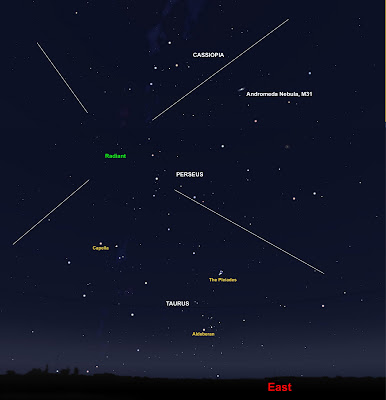


I take a week off and before you know its August, the month where the evening start to very noticeably start drawing in. And it’s not a bad month for looking at the night sky.
This week in particular if you look to the Northwest, Venus Mars and Saturn are almost on top of each other, especially on Saturday when they are within a 5 degree circle. Don’t worry about Mars and Saturn at first, just look for Venus which will visible very soon after Sunset hanging between Samson and the Bishop, looking from St. Mary’s. As the Sun sinks lower Saturn and Mars will come into view, all 3 of them should be easily visible at once in binoculars. By the end of August they will all be setting before 9, so this is the last chance to see them for a while. For this week at least, Mercury will be there but a lot closer to the horizon and may not be visible.
Yesterday Keri was banging on about the Aurora Borealis and he almost sounded like he knew what he was talking about, when the sad reality is that Keri is as much a scientist as John Prescott is a gay icon. Anyway you never know, there’s no moon of consequence for the next two weeks before midnight, so if you see some shimmering to the north it could just be the Northern Lights which are caused by the solar wind, a sort of Astral flatulence interacting with the earths magnetosphere. Which in turn is caused by the huge puddle of molten iron at the earth’s core?
Auroras are the result of the emissions of photons in the Earth's upper atmosphere, above 80 km (50 miles), from ionized nitrogen atoms regaining an electron, and oxygen and nitrogen atoms returning from an excited state to ground state. They are ionized or excited by the collision of solar wind particles being funneled down and accelerated along the Earth's magnetic field lines; excitation energy is lost by the emission of a photon of light, or by collision with another atom or molecule:
As for the moon this month first quarter was yesterday, its New on the tenth and full on the 24th.
And the other highlight of August is the Perseids Meteor Shower. The Perseids is one of the best meteor showers of the year, producing up to 60 meteors per hour at their peak. This year's shower should peak on the night of August 12 and the morning of the 13th, well after the moon has set. But you may be able to see some meteors any time from now to the 22nd. The radiant point for this shower will be, oddly enough, in the constellation Perseus. The thin, crescent moon will be out of the way early, setting the stage for a potentially spectacular show. For best viewing, look to the northeast after midnight.
I’ve put a guide on the blog. Of course the advent of the Perseids has now become a harbinger of doom. It is of course the time of year when the black shadow or she who walks by night begins her annual 8 and half months of plunder. Of course Barbara has already had virtually everything of value, but I’ve heard that this year she will be kidnapping elderly relatives for ransom, so you may want to put that Granny Flat on hold pending further developments.
And that was night sky for the week ending on the 39th anniversary of the founding of the Society for American Baseball in Cooperstown, New York.





